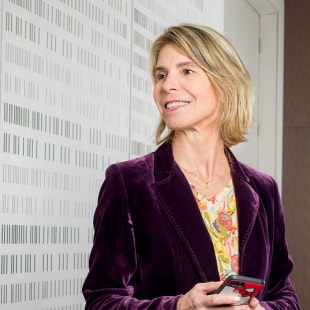The report that BNP Paribas is releasing today announces new 2025 objectives for achieving a “net-zero” or carbon-neutral economy in 2050. What are the key takeaways?
Laurence Pessez (L.P.): This first Climate Analytics and Alignment Report presents our objectives for reducing the intensities of greenhouse gas emissions (GHGs) incurred from our credit activities in three of the most heavily polluting sectors: power generation, oil & gas and automotive. Fossil fuels alone emit more than about 75% of GHGs worldwide. Regardless of the current global context and market turbulences, we feel it is fundamental to have ambitious goals in this area, goals that keep BNP Paribas in phase with the International Energy Agency’s goal of achieving carbon neutrality by 2050 and perhaps even earlier. In fact, in a way we are already there. Today, these three sectors account for just 7% of our financing, thanks to the work the Group has done previously in reducing financing of fossil fuels. Our 2020 starting point is therefore far lower than the global average. Stated very simply, our objective is to reduce CO2 emissions intensity by at least 30% in power generation, by 10% for upstream oil & gas and refining, and by 25% in automotive. We have also chosen to set these portfolio alignment objectives for 2025, whereas most of our peers have opted for a 2030 horizon. We are determined to act now.
Yannick Jung (Y.J.): Quite so, and that also goes for supporting our customers in their own transitions. The head-start mentioned by Laurence allows us to reflect more broadly on the subject, in order to move all BNP Paribas’ business lines at the service of our customers towards an economy that produces less and less CO2 by 2050. To support our customers in their own transitions towards a low-carbon economy, we have made other major commitments for 2025. For example, a package worth at least 200 billion euros will be dedicated to supporting our large corporate customers’ transitions, and we will set aside 350 billion euros in loans and bond issues for environmental and social issues for our corporate customers. We also launched last year the Low Carbon Transition Group, in which 250 experts will do just that – support our customers in this transition towards a low-carbon economy.
Put simply, what does this mean for the Group in terms of its activities?
Y.J.: In April 2021, BNP Paribas was one of the founding members of the Net-Zero Banking Alliance (NZBA). This formalised and strengthened our ambition, announced in 2018, to align the Group’s activities with the objectives of the Paris Agreement. Simply put, under the NZBA, BNP Paribas has pledged since last year to align the greenhouse gas emissions caused by its proprietary credit and investment activities with the trajectory required to achieve carbon neutrality by 2050 and to make a priority of its efforts in sectors that are the heaviest emitters of greenhouse gases. And the objectives announced today are indeed along the lines of the ambitious decisions taken by BNP Paribas over the past several years, decisions that have made it a key player in the transition towards a carbon-neutral economy. In doing so, we will mobilise all our consulting and financing activities, in particular via capital markets, as well as our specialised businesses in order to be our customers’ go-to partner for all their energy transition challenges.
“The objectives announced today are indeed along the lines of the ambitious decisions taken by BNP Paribas over the past several years, decisions that have made it a key player in the transition towards a carbon-neutral economy.”
L.P.: Exactly. The figures are new, but not the direction! Moreover, taking part in this alliance commits us to a broad transparency that I deem essential for anyone having such commitments. NZBA members commit themselves to three important points in particular: to base themselves on credible transition scenarios established by recognised bodies such as the Intergovernmental Panel on Climate Change (IPCC) or the IEA; to set intermediate sector objectives for no later than 2030; and to report annually on their progress and related action plans. Announcing intentions is not enough. Actual objectives are needed, with figures and dates.
More specifically, what are the impacts of these new objectives for our clients?
Y.J.: It
is by offering innovative solutions to its customers that BNP Paribas became a
pioneer in sustainable finance. Our global leadership in this area is reflected
in several rankings: in 2021 alone, the Dealogic financial market platform
ranked BNP Paribas no.2 worldwide for ESG loans and green bonds and no.1 in Europe,
the Middle East and Africa! Euromoney has named us the world’s best bank for
sustainable finance. I am confident that to align our portfolio on our net-zero
objective by 2050 and to continue to play a first-tier role in
decarbonating the economy, we must continue to offer our customers active
support in their transitions. We will do so by mobilising all our teams, through
the investments we make in skills and financings, and through the aggressive
but structured choices we make in reducing our carbon balances.
So, the objectives announced in this report constitute new milestones after regular commitments made over the past decade…
L.P.: Indeed, they do. While sustainability challenges are a key component of our GTS 2025 (Growth, Technology, Sustainability) Strategic Plan, the BNP Paribas Group has, in fact, spent the past 10 years helping to fight climate change. We released our first financing and investment policy in the coal sector in 2010. In 2020 we announced our exit from the entire thermal coal value chain within 10 years in EU and OECD countries and within 20 years in the rest of the world… In 2015, we pledged to double financing of renewable energies within five years, from 7 to 15 billion euros, an amount that we aim to double again by 2025 to 30 billion. As one of the founding members of the Principles of Responsible Banking in 2019 and the NZBA in 2021, in taking part in the Financial Services Task Force, and in making the various commitments mentioned today, BNP Paribas has made the choice of contributing very actively to developing alignment methodologies, practical guides and open-source tools. We strive not just to meet our own climate commitments, but also to share our approach to make it more efficient and more powerful. It is by moving forward all together that we will achieve net-zero by 2050.
Photo credit: Floris Productions/Stocksy







